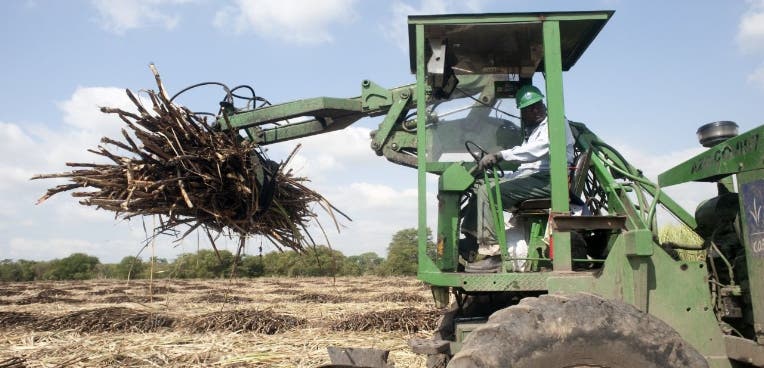The mechanization of sugar cane cutting and harvesting.

Santo Domingo, DR— Since the 1970s, there has been talk in the country about the convenience of mechanizing agricultural work, particularly in the sugar industry.
The sugar sector began a process of technological improvements in the late 19th century. Important technological innovations in the cutting and pulling of sugar cane were implemented starting in 1870 and marked the beginning of modernity in the sugar industry in the Dominican Republic.
“It was not until the 1970s when mechanization began in the State Sugar Council (CEA),” according to Jimmy García Saviñón, former director of the Dominican Sugar Institute (IAD) and former sugar advisor to the Executive Branch, who adds that the process involved land leveling, cleaning, and planting.
He notes, however, that the CEA’s quadrangular planting system made mechanized farming difficult, unlike the rectangular system, which favors it.
In 1970, there were 15 sugar mills in the Dominican Republic. In the 1980s, the state-owned mills Catarey and Esperanza, Santa Fe, and Río Haina closed, and between 1999 and 2000, the capitalization process closed the ten state-owned mills that remained open.
Four mills remained in operation in the country: Central Romana, owned by Central Romana Corporation, Ltd.; Cristóbal Colón, owned by Consorcio Azucarero de Empresas Industriales (CAEI); Barahona, owned by the State but leased to Consorcio Azucarero Central; and Ingenio Porvenir, also owned by the State.
Mechanization favors and complements the use of labor in production, as it reduces extensive processes to more effective and simple ones, as opposed to automation, which dispenses with human participation to provide information or instruction.
To date, there are two successful cases of mechanization and benefits associated with the cutting and pulling of sugar cane in the Central Romana Corporation, Ltd. (CR) and the Consorcio Azucarero De Empresas Industriales (CAEI).
Central Romana automated
Central Romana began the process of mechanizing the cutting and pulling of sugar cane in 1990, with which it achieved 50% automation of cane production, according to data on its web page, and allowed it to dispense with foreign labor for these tasks, mainly Haitian braceros.
The sugar mill’s goal is to cover the entire area under cultivation “to the extent permitted by the topographic conditions of the land, that is, about 75% of the area currently under cultivation since it is not possible to automate the remaining 25% with the available technology, due to the rugged terrain.”
The program includes land preparation, planting, herbicide application, land leveling, cutting, pulling, and transporting the sugarcane from the field to the mill.
CR is betting on concluding its program to become independent: “When the mechanization program is concluded, Central Romana will have practically become independent of imported braceros and will be able to cover all its operations with national labor.”
For mechanized agricultural work, the company has a fleet of 250 tractors with rubber wheels for cane cultivation and pulling; 35 chain tractors for land preparation; 20 graders for road and access road preparation; 47 combined units for cutting, equipment, and machinery that it expects to increase as the mechanization program expands.
However, Central Romana still employs 1,800 carts of six oxen each for: “the work of pulling the cane that is still cut manually, and which are used in the transport to the railroad loading stations strategically located in all the fields under cultivation.”
The Consorcio Azucarero De Empresas Industriales (CAEI)
CAEI also combines specialized labor and machinery for the harvest: “70% of the cane cutting is mechanized and for 30% cutters are used.” According to its website, for “mechanized cutting, CAEI uses modern lifters and harvesters. The use of this machinery guarantees safety and punctuality in the weighing and delivery of the cane” and ensures that the impact on the environment is practically nil.
A combined harvester performs the following tasks: trims the stalks, cuts the stalks at the base, breaks the stalks into small pieces, removes impurities, and prepares the pieces for transport.
In this case, “The Transportation Management is in charge of sending it without delay in trucks or railroad cars to the factory” to guarantee the cane’s yield.
A qualified opinion
García Saviñón explains that while a machine harvests 200 tons of sugar cane, a bracero harvests a maximum of seven, so one machine does the work of 45 people, which translates into harvesting efficiency. Still, he notes that a chopper allows the cane to arrive at the factory cleaner.
The presence of foreign labor in the sugar mills is minimal, he says, and he considers that only three to four years would be needed to complete the mechanization process of the Dominican Republic’s sugar industry, which would imply bringing it up to 85%, which is as far as the surface of the land allows it.
However, García notes that the achievement of this goal would be conditioned by the facilities that the Government could offer to the private sector in terms of taxes and machinery imports.
Status of the construction sector
President Luis Abinader announced, during the eighth edition of the Mesa de la Vivienda de la Asociación Dominicana de Constructores y Promotores de Viviendas (Acoprovi), that the Government will promote a mechanization program to reduce the hiring of foreign labor.
He added that funds were given to the Development and Export Bank (Bandex) for this purpose.
The President called upon the representatives of the construction and housing development sectors to join efforts to implement a national consensus plan called the National Pact for the Haitian Crisis, which will allow to reduce to the minimum the use of foreign braceros.
The construction sector speaks
Acoprovi thanked and welcomed the President’s support for the financing of the mechanization of construction, as well as the technification and training of the labor force, which, according to its President, engineer Annerys Meléndez, “they have historically sought.”
She said that the measure could boost the construction sector through the importation of machinery and make work less rudimentary through the use of materials and tools.
He said that many Dominican workers could participate in the construction work “especially in those initial tasks, such as the gray work.”
According to Meléndez, there are no activities that are 100% mechanized, and to have access to technologies that take it to that level, the sector requires financing and economic facilities that allow a return in a prudent time, so they support the measure announced by the President.
Another challenge, according to Meléndez, is to “lower equipment prices and train personnel.”
He states that the rate of return of the mechanization process is slow to recover and requires significant initial investments.
Chinese donation
The Government of the People’s Republic of China donated 43 machines and equipment to the Ministry of Agriculture. The ambassador to the Dominican Republic, Chen Luning, indicated that they have donated anti-epidemic materials, sugar cane harvesters, sanitation trucks, and now a new batch of agricultural machinery to “help modernize the development of agriculture in the country.”
Yang Haodong, minister of the Propaganda Department of the Hunan Provincial Party Committee, said that the friendly relations between the two countries have allowed him to discuss the mechanization and digitalization of agriculture.

















It is a shame for all the governments, they never invested in agriculture. Always, foreigners have to donate. But then maintenance is another thing!!1
Sounds good. Let’s mechanize the old industry and get the local citizenry good paying jobs!